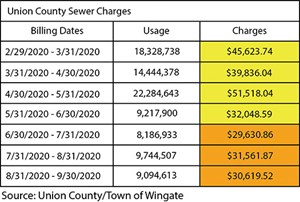June 2022 Vol. 77 No. 6
Rehab Technology
North Carolina Utility Battles I&I with Impressive Results
The Town of Wingate, N.C. Public Works Director Eugene Jones noticed two pump stations were running on average of four hours every day. However, during rain events, the pump stations would run up to 35 hours straight. After further inspection, Jones found that infiltration and inflow (I&I) was the cause of the long run times.
Wingate is a suburb 25 miles east of Charlotte, N.C., with a population of about 3,500. Wingate is most known for Wingate University with more than 3,600 students. The town has a total area of 1.89 square miles – all of it land. Wingate provides retail wastewater service to its citizens and the university and has approximately 23.6 miles of mostly vitrified clay pipe (VCP) and polyvinyl chloride pipe (PVC) pipelines, and 537 manholes that are maintained by the Wingate Public Works Department.
While reviewing the Town’s equipment, it was noticed that two pump stations near Dianne Street were running an average of four hours every day – without a rain event. However, during rain events, the pump stations would run up to 35 hours straight causing strain on the pump equipment, as well as elevated power bills due to excessive run times.
Public Work’s Director Eugene Jones inspected the manholes that fed to the two problematic pump stations. His inspection found that infiltration and inflow (I&I) into the manholes was the culprit causing the long run times of the pumps. Jones contacted Tonia Barton of ProCoat Inc. who specializes in the rehabilitation of sewer manholes and wastewater water treatment plants in North Carolina.
Solution
After further inspection of 61 manholes on the Dianne Street line – approximately half of which were experiencing infiltration – it was concluded that injection grouts would be the ideal solution to eliminate the infiltration flowing through defects. Barton used a combination of injection grouts and used different techniques depending on the manhole’s material. The two grouts used were Avanti’s AV-202 Multigrout and AV-275 Soilgrout.
AV-202 Multigrout is a water-activated polyurethane designed for sealing high-volume water leaks in cracks or joints in concrete structures and is often used in conjunction with AV-219 Fibrotite (Oakum). When Oakum is saturated with grout and then worked into leaking cracks or joints, it is activated by the water leak and acts as a gasket, swelling to shut down the leak.
AV-275 Soilgrout is a hydrophobic polyurethane that uses a catalyst (AV-276) for its reaction and is designed to react quickly with moisture to bind together and waterproof loose granular soils. AV-275 and AV-276 are mixed together prior to injection. AV-275 expands up to 30 times, filling voids around the outside of manholes or other concrete structures.
“Out of the 28 manholes grouted, half were grouted using the curtain grouting technique, and the other half were point repaired,” Barton explained. “Approximately 40 percent of the manholes were brick and mortar which generally required the curtain grouting approach so multiple leaks could be stopped at once. Curtain grouting essentially encapsulates the entire manhole structure creating a waterproof barrier.”
Immediately following completion of the manhole rehabilitation, Jones began to assess the impact of the projects. He found that average run time on the two pump stations went from four hours per day on days without rain to less than one hour – a 75 percent reduction in pump run time. Even more significant was that the pumps went from running up to 35 hours straight during rain events, down to two to 3 hours on average.
To quantify the monetary value of his findings, Jones pulled treatment volume logs and bills from Union County, and electric bills prior to the manhole rehabilitation work, and gathered the same information following the completion of the project:
- Electric cost to power the pump stations went from a three-month average of $452.36 to a three month average of $313.81–a cost reduction of 30.6 percent.
- Treatment volume went from a three-month average of 18,352,586 gallons down to 9,049,780 gallons–a reduction of 50.7 percent in treatment volume.
- Based on the reduction in treatment volume and the cost of treatment, which is $3.62/1,000 gallons, the Town saved approximately $33,000 in treatment costs in addition to electric bill savings over a three-month average.
This manhole rehabilitation project practically paid for itself in cost savings in roughly the first 30 days following the completion of the second phase.
“Manhole rehabilitation has definitely created a benefit for Wingate’s sewer system and eliminating inflow and infiltration with injection grouting was a significant part of that success. The numbers speak for themselves,” Jones pointed out.
Jones is currently working towards a third phase to continue his success with manhole and pump station rehabilitation.
FOR MORE INFORMATION:
Avanti, (281) 486-5600, avantigrout.com
ProCoat, (336) 908-7053, procoatcorp.com





Comments